Visitor Attraction Management Strategies
VerifiedAdded on 2020/06/04
|21
|4740
|73
AI Summary
This assignment delves into the multifaceted aspects of visitor attraction management. It examines various segmentation strategies to target diverse visitor groups and emphasizes the significance of smart technologies in enhancing visitor experiences. The document also explores key considerations for staff training and volunteer involvement, highlighting best practices for revenue generation and event management within visitor attractions.
Contribute Materials
Your contribution can guide someone’s learning journey. Share your
documents today.

VISITORS
ATTRACTION
ATTRACTION
Secure Best Marks with AI Grader
Need help grading? Try our AI Grader for instant feedback on your assignments.

Table of Contents
INTRODUCTION ..........................................................................................................................1
TASK 1 ...........................................................................................................................................1
1.1Visitors attraction overlap in context to the types of attraction.............................................1
TASK 2............................................................................................................................................4
2.1 Motivations and needs of the different tourists type.............................................................4
2.2 Impacts of the tourism on the tourists attraction..................................................................6
2.3 Impact of the various theories of the visitors motivation......................................................7
TASK 3 ..........................................................................................................................................9
TASK 4 .........................................................................................................................................15
4.1 Various visitor management strategies...............................................................................15
4.2 Management techniques in relation to sustainability..........................................................16
CONCLUSION .............................................................................................................................17
REFERANCES..............................................................................................................................18
INTRODUCTION ..........................................................................................................................1
TASK 1 ...........................................................................................................................................1
1.1Visitors attraction overlap in context to the types of attraction.............................................1
TASK 2............................................................................................................................................4
2.1 Motivations and needs of the different tourists type.............................................................4
2.2 Impacts of the tourism on the tourists attraction..................................................................6
2.3 Impact of the various theories of the visitors motivation......................................................7
TASK 3 ..........................................................................................................................................9
TASK 4 .........................................................................................................................................15
4.1 Various visitor management strategies...............................................................................15
4.2 Management techniques in relation to sustainability..........................................................16
CONCLUSION .............................................................................................................................17
REFERANCES..............................................................................................................................18
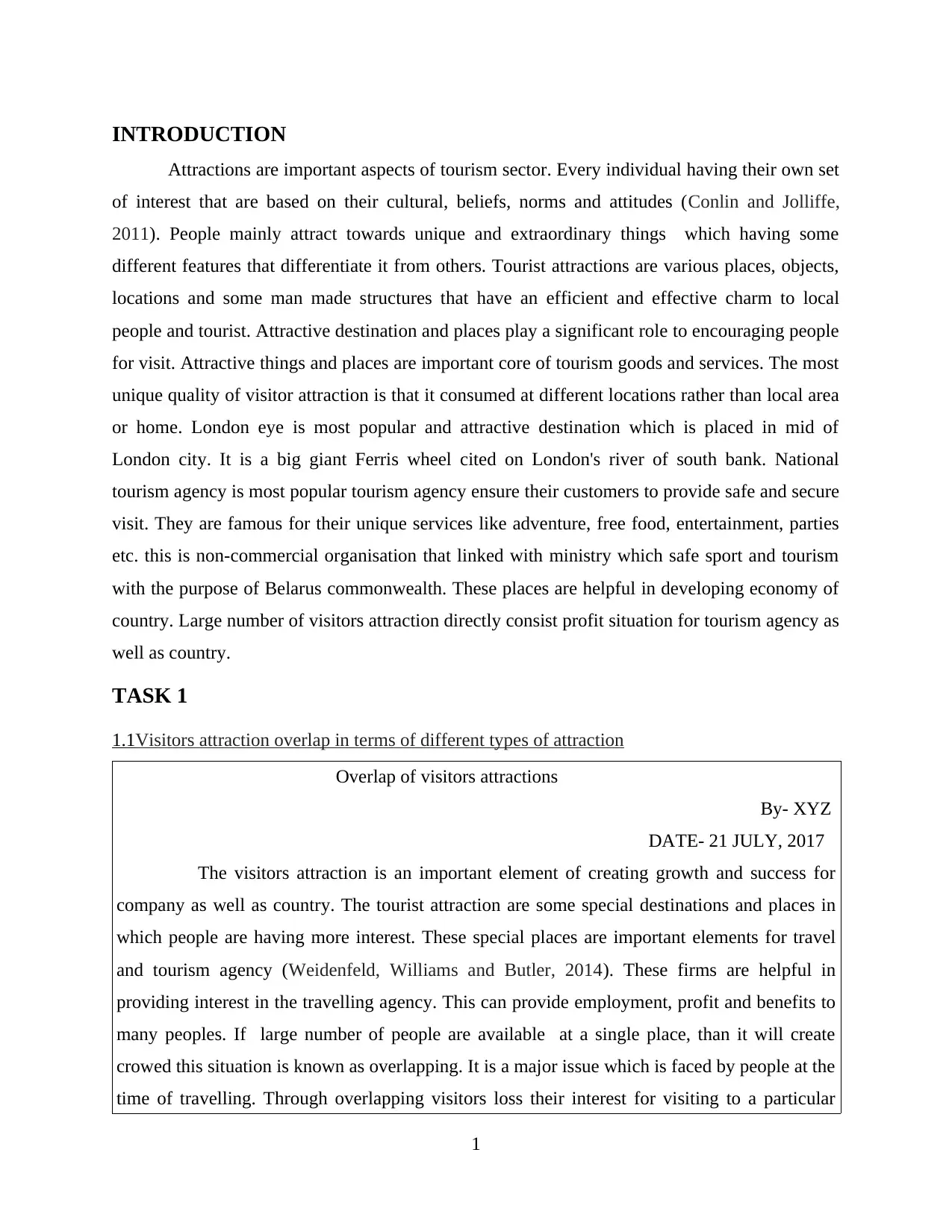
INTRODUCTION
Attractions are important aspects of tourism sector. Every individual having their own set
of interest that are based on their cultural, beliefs, norms and attitudes (Conlin and Jolliffe,
2011). People mainly attract towards unique and extraordinary things which having some
different features that differentiate it from others. Tourist attractions are various places, objects,
locations and some man made structures that have an efficient and effective charm to local
people and tourist. Attractive destination and places play a significant role to encouraging people
for visit. Attractive things and places are important core of tourism goods and services. The most
unique quality of visitor attraction is that it consumed at different locations rather than local area
or home. London eye is most popular and attractive destination which is placed in mid of
London city. It is a big giant Ferris wheel cited on London's river of south bank. National
tourism agency is most popular tourism agency ensure their customers to provide safe and secure
visit. They are famous for their unique services like adventure, free food, entertainment, parties
etc. this is non-commercial organisation that linked with ministry which safe sport and tourism
with the purpose of Belarus commonwealth. These places are helpful in developing economy of
country. Large number of visitors attraction directly consist profit situation for tourism agency as
well as country.
TASK 1
1.1Visitors attraction overlap in terms of different types of attraction
Overlap of visitors attractions
By- XYZ
DATE- 21 JULY, 2017
The visitors attraction is an important element of creating growth and success for
company as well as country. The tourist attraction are some special destinations and places in
which people are having more interest. These special places are important elements for travel
and tourism agency (Weidenfeld, Williams and Butler, 2014). These firms are helpful in
providing interest in the travelling agency. This can provide employment, profit and benefits to
many peoples. If large number of people are available at a single place, than it will create
crowed this situation is known as overlapping. It is a major issue which is faced by people at the
time of travelling. Through overlapping visitors loss their interest for visiting to a particular
1
Attractions are important aspects of tourism sector. Every individual having their own set
of interest that are based on their cultural, beliefs, norms and attitudes (Conlin and Jolliffe,
2011). People mainly attract towards unique and extraordinary things which having some
different features that differentiate it from others. Tourist attractions are various places, objects,
locations and some man made structures that have an efficient and effective charm to local
people and tourist. Attractive destination and places play a significant role to encouraging people
for visit. Attractive things and places are important core of tourism goods and services. The most
unique quality of visitor attraction is that it consumed at different locations rather than local area
or home. London eye is most popular and attractive destination which is placed in mid of
London city. It is a big giant Ferris wheel cited on London's river of south bank. National
tourism agency is most popular tourism agency ensure their customers to provide safe and secure
visit. They are famous for their unique services like adventure, free food, entertainment, parties
etc. this is non-commercial organisation that linked with ministry which safe sport and tourism
with the purpose of Belarus commonwealth. These places are helpful in developing economy of
country. Large number of visitors attraction directly consist profit situation for tourism agency as
well as country.
TASK 1
1.1Visitors attraction overlap in terms of different types of attraction
Overlap of visitors attractions
By- XYZ
DATE- 21 JULY, 2017
The visitors attraction is an important element of creating growth and success for
company as well as country. The tourist attraction are some special destinations and places in
which people are having more interest. These special places are important elements for travel
and tourism agency (Weidenfeld, Williams and Butler, 2014). These firms are helpful in
providing interest in the travelling agency. This can provide employment, profit and benefits to
many peoples. If large number of people are available at a single place, than it will create
crowed this situation is known as overlapping. It is a major issue which is faced by people at the
time of travelling. Through overlapping visitors loss their interest for visiting to a particular
1
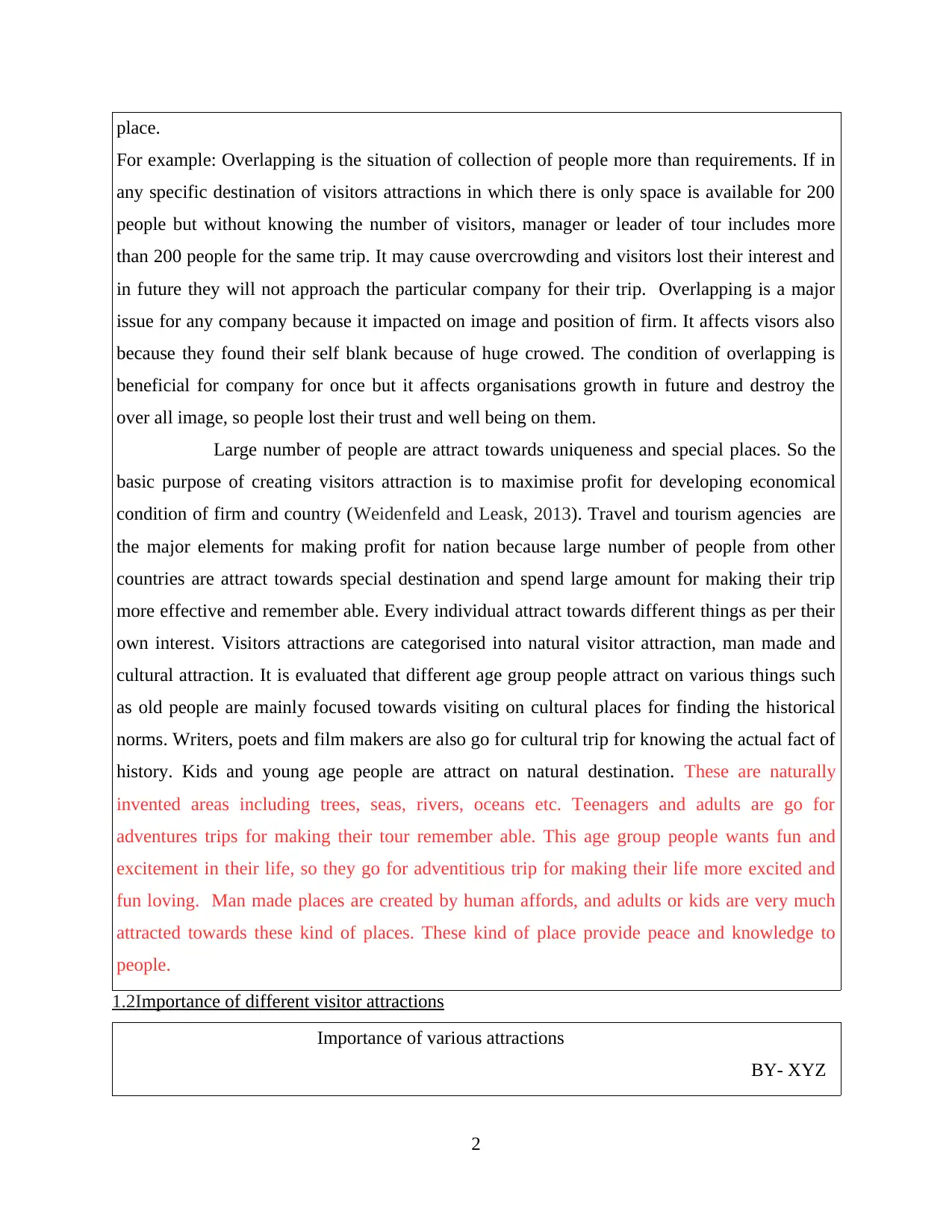
place.
For example: Overlapping is the situation of collection of people more than requirements. If in
any specific destination of visitors attractions in which there is only space is available for 200
people but without knowing the number of visitors, manager or leader of tour includes more
than 200 people for the same trip. It may cause overcrowding and visitors lost their interest and
in future they will not approach the particular company for their trip. Overlapping is a major
issue for any company because it impacted on image and position of firm. It affects visors also
because they found their self blank because of huge crowed. The condition of overlapping is
beneficial for company for once but it affects organisations growth in future and destroy the
over all image, so people lost their trust and well being on them.
Large number of people are attract towards uniqueness and special places. So the
basic purpose of creating visitors attraction is to maximise profit for developing economical
condition of firm and country (Weidenfeld and Leask, 2013). Travel and tourism agencies are
the major elements for making profit for nation because large number of people from other
countries are attract towards special destination and spend large amount for making their trip
more effective and remember able. Every individual attract towards different things as per their
own interest. Visitors attractions are categorised into natural visitor attraction, man made and
cultural attraction. It is evaluated that different age group people attract on various things such
as old people are mainly focused towards visiting on cultural places for finding the historical
norms. Writers, poets and film makers are also go for cultural trip for knowing the actual fact of
history. Kids and young age people are attract on natural destination. These are naturally
invented areas including trees, seas, rivers, oceans etc. Teenagers and adults are go for
adventures trips for making their tour remember able. This age group people wants fun and
excitement in their life, so they go for adventitious trip for making their life more excited and
fun loving. Man made places are created by human affords, and adults or kids are very much
attracted towards these kind of places. These kind of place provide peace and knowledge to
people.
1.2Importance of different visitor attractions
Importance of various attractions
BY- XYZ
2
For example: Overlapping is the situation of collection of people more than requirements. If in
any specific destination of visitors attractions in which there is only space is available for 200
people but without knowing the number of visitors, manager or leader of tour includes more
than 200 people for the same trip. It may cause overcrowding and visitors lost their interest and
in future they will not approach the particular company for their trip. Overlapping is a major
issue for any company because it impacted on image and position of firm. It affects visors also
because they found their self blank because of huge crowed. The condition of overlapping is
beneficial for company for once but it affects organisations growth in future and destroy the
over all image, so people lost their trust and well being on them.
Large number of people are attract towards uniqueness and special places. So the
basic purpose of creating visitors attraction is to maximise profit for developing economical
condition of firm and country (Weidenfeld and Leask, 2013). Travel and tourism agencies are
the major elements for making profit for nation because large number of people from other
countries are attract towards special destination and spend large amount for making their trip
more effective and remember able. Every individual attract towards different things as per their
own interest. Visitors attractions are categorised into natural visitor attraction, man made and
cultural attraction. It is evaluated that different age group people attract on various things such
as old people are mainly focused towards visiting on cultural places for finding the historical
norms. Writers, poets and film makers are also go for cultural trip for knowing the actual fact of
history. Kids and young age people are attract on natural destination. These are naturally
invented areas including trees, seas, rivers, oceans etc. Teenagers and adults are go for
adventures trips for making their tour remember able. This age group people wants fun and
excitement in their life, so they go for adventitious trip for making their life more excited and
fun loving. Man made places are created by human affords, and adults or kids are very much
attracted towards these kind of places. These kind of place provide peace and knowledge to
people.
1.2Importance of different visitor attractions
Importance of various attractions
BY- XYZ
2
Secure Best Marks with AI Grader
Need help grading? Try our AI Grader for instant feedback on your assignments.
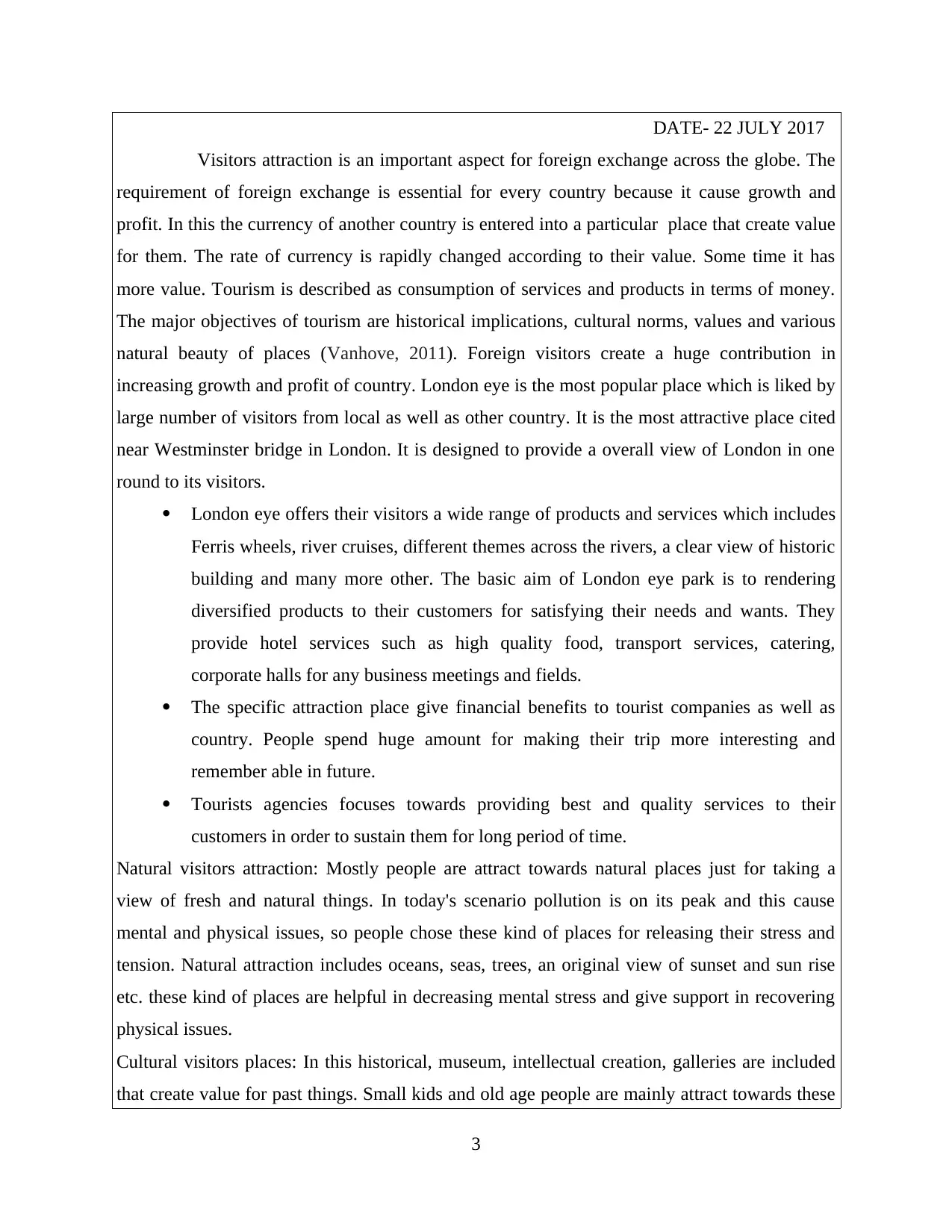
DATE- 22 JULY 2017
Visitors attraction is an important aspect for foreign exchange across the globe. The
requirement of foreign exchange is essential for every country because it cause growth and
profit. In this the currency of another country is entered into a particular place that create value
for them. The rate of currency is rapidly changed according to their value. Some time it has
more value. Tourism is described as consumption of services and products in terms of money.
The major objectives of tourism are historical implications, cultural norms, values and various
natural beauty of places (Vanhove, 2011). Foreign visitors create a huge contribution in
increasing growth and profit of country. London eye is the most popular place which is liked by
large number of visitors from local as well as other country. It is the most attractive place cited
near Westminster bridge in London. It is designed to provide a overall view of London in one
round to its visitors.
London eye offers their visitors a wide range of products and services which includes
Ferris wheels, river cruises, different themes across the rivers, a clear view of historic
building and many more other. The basic aim of London eye park is to rendering
diversified products to their customers for satisfying their needs and wants. They
provide hotel services such as high quality food, transport services, catering,
corporate halls for any business meetings and fields.
The specific attraction place give financial benefits to tourist companies as well as
country. People spend huge amount for making their trip more interesting and
remember able in future.
Tourists agencies focuses towards providing best and quality services to their
customers in order to sustain them for long period of time.
Natural visitors attraction: Mostly people are attract towards natural places just for taking a
view of fresh and natural things. In today's scenario pollution is on its peak and this cause
mental and physical issues, so people chose these kind of places for releasing their stress and
tension. Natural attraction includes oceans, seas, trees, an original view of sunset and sun rise
etc. these kind of places are helpful in decreasing mental stress and give support in recovering
physical issues.
Cultural visitors places: In this historical, museum, intellectual creation, galleries are included
that create value for past things. Small kids and old age people are mainly attract towards these
3
Visitors attraction is an important aspect for foreign exchange across the globe. The
requirement of foreign exchange is essential for every country because it cause growth and
profit. In this the currency of another country is entered into a particular place that create value
for them. The rate of currency is rapidly changed according to their value. Some time it has
more value. Tourism is described as consumption of services and products in terms of money.
The major objectives of tourism are historical implications, cultural norms, values and various
natural beauty of places (Vanhove, 2011). Foreign visitors create a huge contribution in
increasing growth and profit of country. London eye is the most popular place which is liked by
large number of visitors from local as well as other country. It is the most attractive place cited
near Westminster bridge in London. It is designed to provide a overall view of London in one
round to its visitors.
London eye offers their visitors a wide range of products and services which includes
Ferris wheels, river cruises, different themes across the rivers, a clear view of historic
building and many more other. The basic aim of London eye park is to rendering
diversified products to their customers for satisfying their needs and wants. They
provide hotel services such as high quality food, transport services, catering,
corporate halls for any business meetings and fields.
The specific attraction place give financial benefits to tourist companies as well as
country. People spend huge amount for making their trip more interesting and
remember able in future.
Tourists agencies focuses towards providing best and quality services to their
customers in order to sustain them for long period of time.
Natural visitors attraction: Mostly people are attract towards natural places just for taking a
view of fresh and natural things. In today's scenario pollution is on its peak and this cause
mental and physical issues, so people chose these kind of places for releasing their stress and
tension. Natural attraction includes oceans, seas, trees, an original view of sunset and sun rise
etc. these kind of places are helpful in decreasing mental stress and give support in recovering
physical issues.
Cultural visitors places: In this historical, museum, intellectual creation, galleries are included
that create value for past things. Small kids and old age people are mainly attract towards these
3
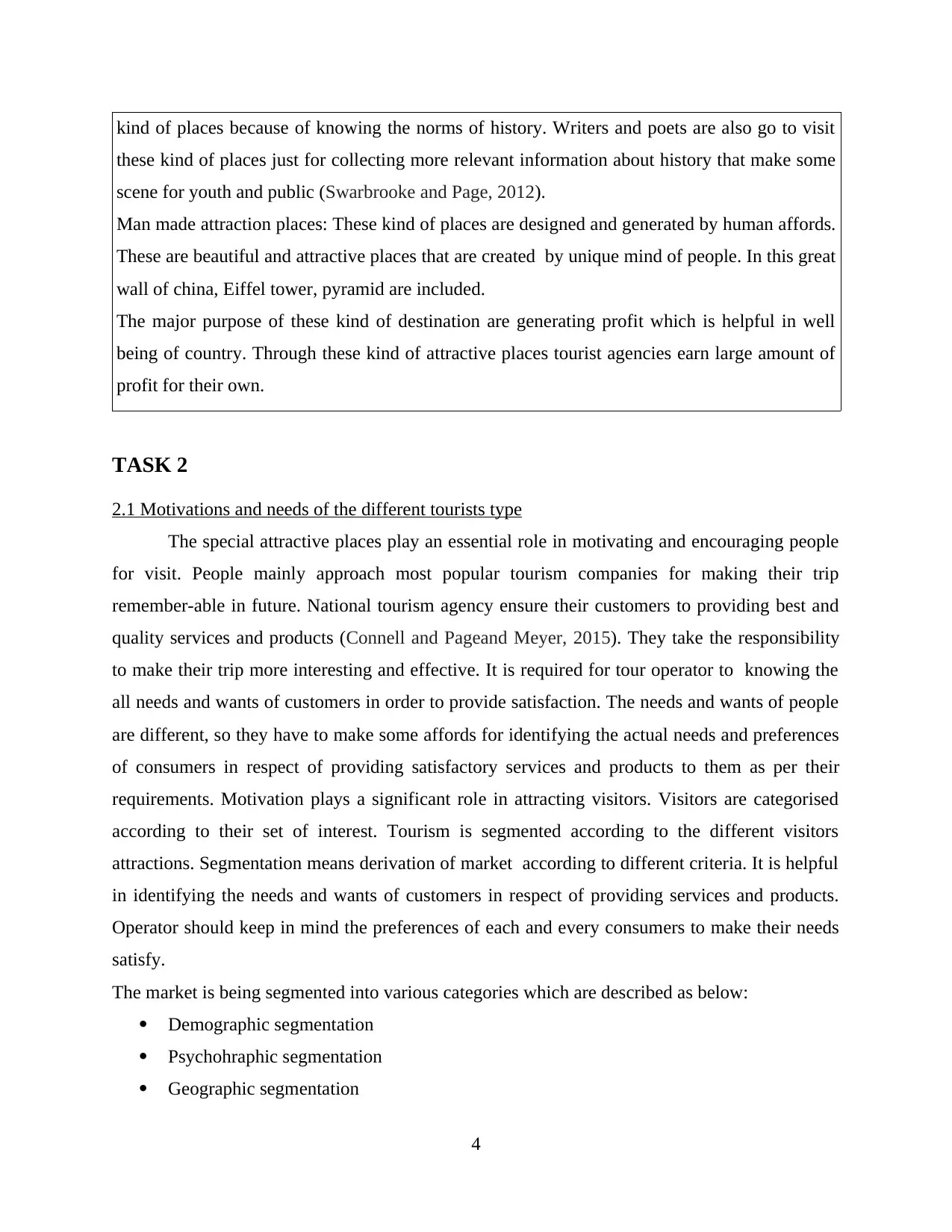
kind of places because of knowing the norms of history. Writers and poets are also go to visit
these kind of places just for collecting more relevant information about history that make some
scene for youth and public (Swarbrooke and Page, 2012).
Man made attraction places: These kind of places are designed and generated by human affords.
These are beautiful and attractive places that are created by unique mind of people. In this great
wall of china, Eiffel tower, pyramid are included.
The major purpose of these kind of destination are generating profit which is helpful in well
being of country. Through these kind of attractive places tourist agencies earn large amount of
profit for their own.
TASK 2
2.1 Motivations and needs of the different tourists type
The special attractive places play an essential role in motivating and encouraging people
for visit. People mainly approach most popular tourism companies for making their trip
remember-able in future. National tourism agency ensure their customers to providing best and
quality services and products (Connell and Pageand Meyer, 2015). They take the responsibility
to make their trip more interesting and effective. It is required for tour operator to knowing the
all needs and wants of customers in order to provide satisfaction. The needs and wants of people
are different, so they have to make some affords for identifying the actual needs and preferences
of consumers in respect of providing satisfactory services and products to them as per their
requirements. Motivation plays a significant role in attracting visitors. Visitors are categorised
according to their set of interest. Tourism is segmented according to the different visitors
attractions. Segmentation means derivation of market according to different criteria. It is helpful
in identifying the needs and wants of customers in respect of providing services and products.
Operator should keep in mind the preferences of each and every consumers to make their needs
satisfy.
The market is being segmented into various categories which are described as below:
Demographic segmentation
Psychohraphic segmentation
Geographic segmentation
4
these kind of places just for collecting more relevant information about history that make some
scene for youth and public (Swarbrooke and Page, 2012).
Man made attraction places: These kind of places are designed and generated by human affords.
These are beautiful and attractive places that are created by unique mind of people. In this great
wall of china, Eiffel tower, pyramid are included.
The major purpose of these kind of destination are generating profit which is helpful in well
being of country. Through these kind of attractive places tourist agencies earn large amount of
profit for their own.
TASK 2
2.1 Motivations and needs of the different tourists type
The special attractive places play an essential role in motivating and encouraging people
for visit. People mainly approach most popular tourism companies for making their trip
remember-able in future. National tourism agency ensure their customers to providing best and
quality services and products (Connell and Pageand Meyer, 2015). They take the responsibility
to make their trip more interesting and effective. It is required for tour operator to knowing the
all needs and wants of customers in order to provide satisfaction. The needs and wants of people
are different, so they have to make some affords for identifying the actual needs and preferences
of consumers in respect of providing satisfactory services and products to them as per their
requirements. Motivation plays a significant role in attracting visitors. Visitors are categorised
according to their set of interest. Tourism is segmented according to the different visitors
attractions. Segmentation means derivation of market according to different criteria. It is helpful
in identifying the needs and wants of customers in respect of providing services and products.
Operator should keep in mind the preferences of each and every consumers to make their needs
satisfy.
The market is being segmented into various categories which are described as below:
Demographic segmentation
Psychohraphic segmentation
Geographic segmentation
4

Behavioural segmentation
(Source: Bases of segmentation 2017) Demographic segmentation: In this segmentation is categorised as per age, gender,
income, occupation, family size, religion and nationality of person. National tourism
agency identify the needs of customers on the basic of market segmentation, it is very
easy for fir to evaluate actual wants of customers (Day and et.al., 2013). The basic aim
of every firm is to fulfil the needs of customers in order to earn more profit and revenue.
In demographic segmentation firms divide their customers as per different criteria
because nation tourism agency is mainly focuses on high income people. It is easy for
well settled people to spend huge amount of rupee on their comfort. Tour operator
categories their visitors as per their different needs and wants, so it is easy for them to
provide satisfactory services to their potential buyers.
5
Illustration 1: BASES OF SEGMENTATION
(Source: Bases of segmentation 2017) Demographic segmentation: In this segmentation is categorised as per age, gender,
income, occupation, family size, religion and nationality of person. National tourism
agency identify the needs of customers on the basic of market segmentation, it is very
easy for fir to evaluate actual wants of customers (Day and et.al., 2013). The basic aim
of every firm is to fulfil the needs of customers in order to earn more profit and revenue.
In demographic segmentation firms divide their customers as per different criteria
because nation tourism agency is mainly focuses on high income people. It is easy for
well settled people to spend huge amount of rupee on their comfort. Tour operator
categories their visitors as per their different needs and wants, so it is easy for them to
provide satisfactory services to their potential buyers.
5
Illustration 1: BASES OF SEGMENTATION
Paraphrase This Document
Need a fresh take? Get an instant paraphrase of this document with our AI Paraphraser

Psychographic segmentation: This is most essential part of market segmentation, in this
categorisation is created on the basis of persons personal values and life style. In this
attitude, interest, and life style play a significant role. National tourism agency appoint
an operator who is responsible for for fulfilling the actual needs of customers. Geographic segmentation: In this the total market is divided according to different
criteria. This is mainly concern towards categorisation of market as per geographic
criteria. This includes climate, density of population, city area, subway stations and
many more. This segmentation is impacted on overall performance of firm (Dewhurst
and Thwaites, 2014).
Behaviour segmentation: This segmentation is based on different behaviour of person
because the behaviour of person is based on their attitude, norms and beliefs. Company
concern towards different behaviour of visitors and provide products and services as per
their response. A good behaviour consist benefits for future. If the customers are
satisfied with the offered services and goods that they always approach the same industry
for their future trips. In this the visitors and customers are divided on the basis of
different groups which includes status of people, readiness of buyers, occasion and
loyalty status. National visitors agency design their prospectus including various aspects
and suggest best offerers to their consumers as per their status and standard.
2.2 Impacts of the tourism on the tourists attraction
Tourism attraction is important for tourism sector, it involves positive and negative
effects on tourism. Every firm is focused towards rendering quality services to their clients in
respect of maximise profit an revenue. It is required for operator to provide best services to their
potential customers, if the service of company is not good than it may affect the overall
performance and directly impacted of brand image of industry. Traffic-related issues, pollutions,
overcrowding and facilities are some important factors which are described as below:
Pollutions: This is major factors that affect the visitors attraction. In today's world
pollution is cause due to factory industry and these explore some negative guess which are
harmful for health and wealth. If any factories are located near to the special destination than it
surely affect the place. It is important duty for government to keep an eye on that, the industrial
area should be cited far from visitors attraction (Ezeuduji, 2015). This situation is impacted on
6
categorisation is created on the basis of persons personal values and life style. In this
attitude, interest, and life style play a significant role. National tourism agency appoint
an operator who is responsible for for fulfilling the actual needs of customers. Geographic segmentation: In this the total market is divided according to different
criteria. This is mainly concern towards categorisation of market as per geographic
criteria. This includes climate, density of population, city area, subway stations and
many more. This segmentation is impacted on overall performance of firm (Dewhurst
and Thwaites, 2014).
Behaviour segmentation: This segmentation is based on different behaviour of person
because the behaviour of person is based on their attitude, norms and beliefs. Company
concern towards different behaviour of visitors and provide products and services as per
their response. A good behaviour consist benefits for future. If the customers are
satisfied with the offered services and goods that they always approach the same industry
for their future trips. In this the visitors and customers are divided on the basis of
different groups which includes status of people, readiness of buyers, occasion and
loyalty status. National visitors agency design their prospectus including various aspects
and suggest best offerers to their consumers as per their status and standard.
2.2 Impacts of the tourism on the tourists attraction
Tourism attraction is important for tourism sector, it involves positive and negative
effects on tourism. Every firm is focused towards rendering quality services to their clients in
respect of maximise profit an revenue. It is required for operator to provide best services to their
potential customers, if the service of company is not good than it may affect the overall
performance and directly impacted of brand image of industry. Traffic-related issues, pollutions,
overcrowding and facilities are some important factors which are described as below:
Pollutions: This is major factors that affect the visitors attraction. In today's world
pollution is cause due to factory industry and these explore some negative guess which are
harmful for health and wealth. If any factories are located near to the special destination than it
surely affect the place. It is important duty for government to keep an eye on that, the industrial
area should be cited far from visitors attraction (Ezeuduji, 2015). This situation is impacted on
6

tourist agencies also because, visitors are not interested to visit any place which are affected by
pollution.
Overcrowding: This is a major factor that affect the interest of visitors. This also
impacted on tourist agencies. Some people want peaceful environment for their trip, so they
avoid those places which are always full by large number of people. Many agencies are focused
to earn profit and they include large number of visitors in their trip, this situation cause
overlapping. In this condition people lost their interest from the place and feel frustrated. It
affects the tourism (Hassan, 2013). Large number of people lost their interest on the visitors
attraction and never approach the place for their future trip. It also affect the operation and
productivity of firm.
Traffic problem: This is an essential issue which affects the consumers attraction. In the
area of city traffic is normal, it is easy for local people to handle traffic, but outsiders got
frustrated with traffic. Large number of customers are not aware about the other countries traffic
rules, so national tour operators always provide the all detail about the cited place. They take the
responsibility to provide a comfortable transportation to their clients in order to provide
satisfactory services. If operator not able to provide best service than visitors can easily switch
the company for their future trips.
Facilities: Every consumer want best service in respect of money. They pay for each and
every product and services and expect facilities. National tourism is focused towards rendering
effective service to their customers in order to maximise their revenue.
Positive impact of tourism:
Economic effect: Tourism makes job opportunities for people through both direct and
indirect employment. Tourism is also provide facilities to small scale industries that are mostly
important for rural people.
Social effects: If there is an improvement in infrastructure than the people of society will
be benefited. Tourism is helpful in encouraging traditional costumes, festivals and handicrafts.
Interchanges among hosts and clients make an effective understanding that can also provide help
to raise awareness of problems like human rights abuse and poverty.
Environmental effects: It helps in protection of wildlife and natural resources which
includes forest and rain etc. funds are generated to maintaining wild life.
7
pollution.
Overcrowding: This is a major factor that affect the interest of visitors. This also
impacted on tourist agencies. Some people want peaceful environment for their trip, so they
avoid those places which are always full by large number of people. Many agencies are focused
to earn profit and they include large number of visitors in their trip, this situation cause
overlapping. In this condition people lost their interest from the place and feel frustrated. It
affects the tourism (Hassan, 2013). Large number of people lost their interest on the visitors
attraction and never approach the place for their future trip. It also affect the operation and
productivity of firm.
Traffic problem: This is an essential issue which affects the consumers attraction. In the
area of city traffic is normal, it is easy for local people to handle traffic, but outsiders got
frustrated with traffic. Large number of customers are not aware about the other countries traffic
rules, so national tour operators always provide the all detail about the cited place. They take the
responsibility to provide a comfortable transportation to their clients in order to provide
satisfactory services. If operator not able to provide best service than visitors can easily switch
the company for their future trips.
Facilities: Every consumer want best service in respect of money. They pay for each and
every product and services and expect facilities. National tourism is focused towards rendering
effective service to their customers in order to maximise their revenue.
Positive impact of tourism:
Economic effect: Tourism makes job opportunities for people through both direct and
indirect employment. Tourism is also provide facilities to small scale industries that are mostly
important for rural people.
Social effects: If there is an improvement in infrastructure than the people of society will
be benefited. Tourism is helpful in encouraging traditional costumes, festivals and handicrafts.
Interchanges among hosts and clients make an effective understanding that can also provide help
to raise awareness of problems like human rights abuse and poverty.
Environmental effects: It helps in protection of wildlife and natural resources which
includes forest and rain etc. funds are generated to maintaining wild life.
7

2.3 Impact of the various theories of the visitors motivation
The motivational theory play an essential role in encouraging people to visit various
attractive places. National tourism agency follow various tools and techniques for attract large
number of visitors towards their organisation. Motivation help is creating sustainability for
company. London eye is most attractive visiting place which provide overview of city in one
round. Firms always try to give best quality products and services that meet with the actual needs
of consumers (Leask, Fyall and Barron, 2013). Motivational theories have positively impacted
on overall performance of company. Some tourist motivations are described as below:
Responsible tourism: This is the company give surety to their customers to provide safe,
secure and comfortable trip. According to the theory of responsible tourism the tourist agency
need to provide satisfactory service to their potential buyers in respect of maximise profit. The
local and government authority play a significant role to attract large number of people towards
the special places. Local people give detail about the destination and describe the speciality of
that particular place. Government try to support the tourism agency through keep the place clean
and tidy. People mostly attract towards cleaned things. This theory helps in reducing negative
effect from environmental, social and economical factors. It provide benefits to their local
authorities (Leask, Fyall and Garrod, 2013).
Smart consumers: This theory is helpful in describing the roles, duties and
responsibilities of visitors. It is required for travel agency to mention all roles of customers
which need to be followed by them in an effective manner. The major responsibility of visitors is
to keep the special destination clean. The need needs to taking care of their personal things and
their self. It helps to create positive contribution on the different cultural of visitors attraction.
8
The motivational theory play an essential role in encouraging people to visit various
attractive places. National tourism agency follow various tools and techniques for attract large
number of visitors towards their organisation. Motivation help is creating sustainability for
company. London eye is most attractive visiting place which provide overview of city in one
round. Firms always try to give best quality products and services that meet with the actual needs
of consumers (Leask, Fyall and Barron, 2013). Motivational theories have positively impacted
on overall performance of company. Some tourist motivations are described as below:
Responsible tourism: This is the company give surety to their customers to provide safe,
secure and comfortable trip. According to the theory of responsible tourism the tourist agency
need to provide satisfactory service to their potential buyers in respect of maximise profit. The
local and government authority play a significant role to attract large number of people towards
the special places. Local people give detail about the destination and describe the speciality of
that particular place. Government try to support the tourism agency through keep the place clean
and tidy. People mostly attract towards cleaned things. This theory helps in reducing negative
effect from environmental, social and economical factors. It provide benefits to their local
authorities (Leask, Fyall and Garrod, 2013).
Smart consumers: This theory is helpful in describing the roles, duties and
responsibilities of visitors. It is required for travel agency to mention all roles of customers
which need to be followed by them in an effective manner. The major responsibility of visitors is
to keep the special destination clean. The need needs to taking care of their personal things and
their self. It helps to create positive contribution on the different cultural of visitors attraction.
8
Secure Best Marks with AI Grader
Need help grading? Try our AI Grader for instant feedback on your assignments.
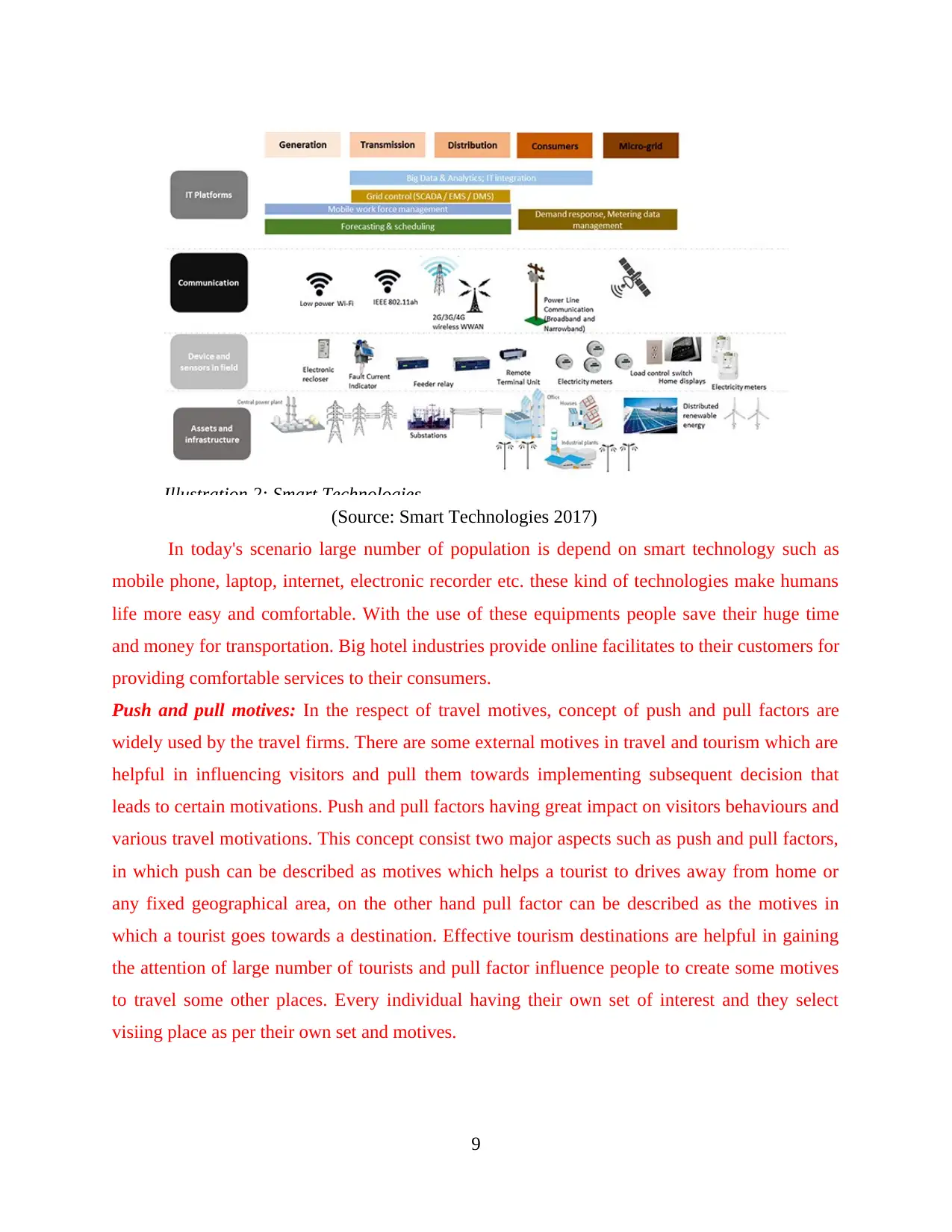
(Source: Smart Technologies 2017)
In today's scenario large number of population is depend on smart technology such as
mobile phone, laptop, internet, electronic recorder etc. these kind of technologies make humans
life more easy and comfortable. With the use of these equipments people save their huge time
and money for transportation. Big hotel industries provide online facilitates to their customers for
providing comfortable services to their consumers.
Push and pull motives: In the respect of travel motives, concept of push and pull factors are
widely used by the travel firms. There are some external motives in travel and tourism which are
helpful in influencing visitors and pull them towards implementing subsequent decision that
leads to certain motivations. Push and pull factors having great impact on visitors behaviours and
various travel motivations. This concept consist two major aspects such as push and pull factors,
in which push can be described as motives which helps a tourist to drives away from home or
any fixed geographical area, on the other hand pull factor can be described as the motives in
which a tourist goes towards a destination. Effective tourism destinations are helpful in gaining
the attention of large number of tourists and pull factor influence people to create some motives
to travel some other places. Every individual having their own set of interest and they select
visiing place as per their own set and motives.
9
Illustration 2: Smart Technologies
In today's scenario large number of population is depend on smart technology such as
mobile phone, laptop, internet, electronic recorder etc. these kind of technologies make humans
life more easy and comfortable. With the use of these equipments people save their huge time
and money for transportation. Big hotel industries provide online facilitates to their customers for
providing comfortable services to their consumers.
Push and pull motives: In the respect of travel motives, concept of push and pull factors are
widely used by the travel firms. There are some external motives in travel and tourism which are
helpful in influencing visitors and pull them towards implementing subsequent decision that
leads to certain motivations. Push and pull factors having great impact on visitors behaviours and
various travel motivations. This concept consist two major aspects such as push and pull factors,
in which push can be described as motives which helps a tourist to drives away from home or
any fixed geographical area, on the other hand pull factor can be described as the motives in
which a tourist goes towards a destination. Effective tourism destinations are helpful in gaining
the attention of large number of tourists and pull factor influence people to create some motives
to travel some other places. Every individual having their own set of interest and they select
visiing place as per their own set and motives.
9
Illustration 2: Smart Technologies
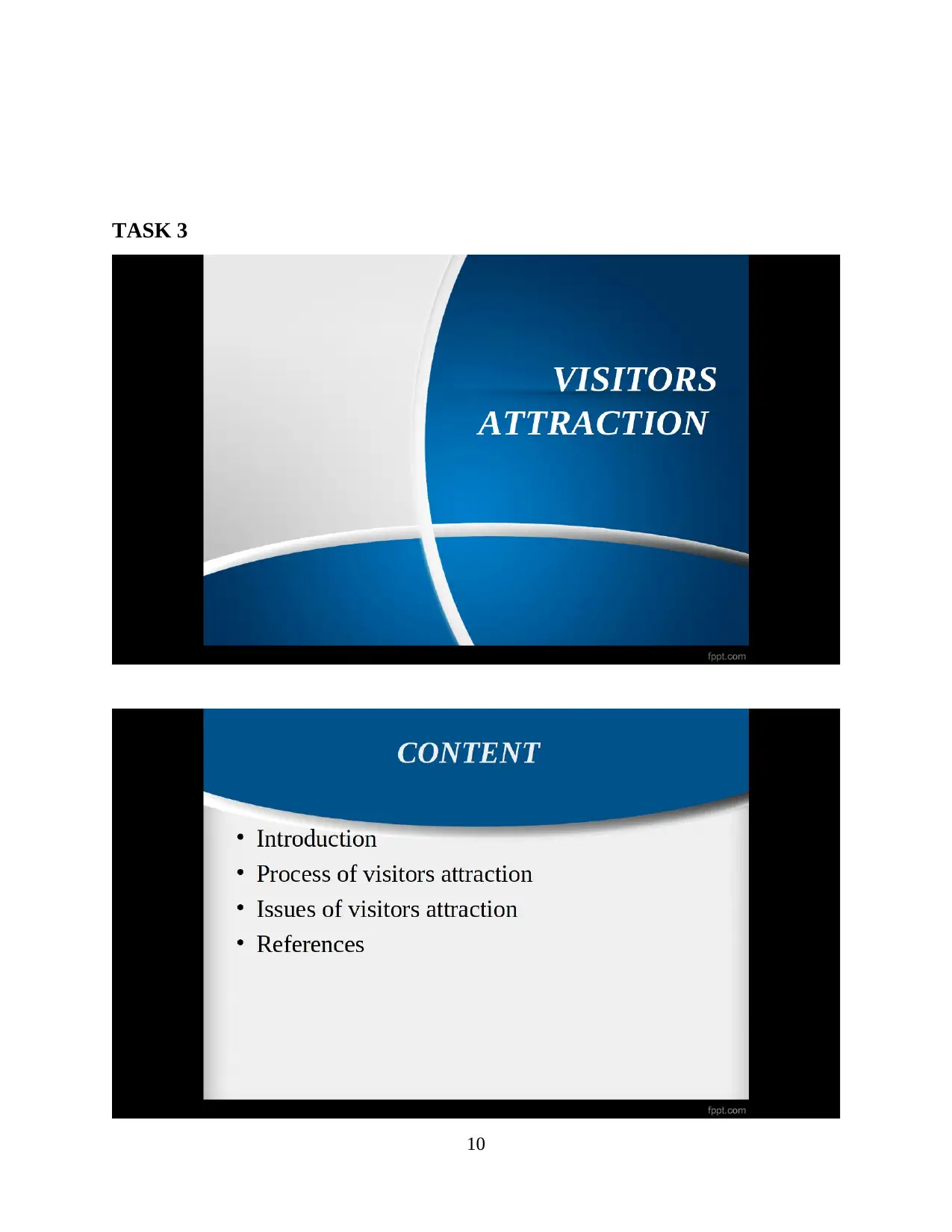
TASK 3
10
10

11
Paraphrase This Document
Need a fresh take? Get an instant paraphrase of this document with our AI Paraphraser
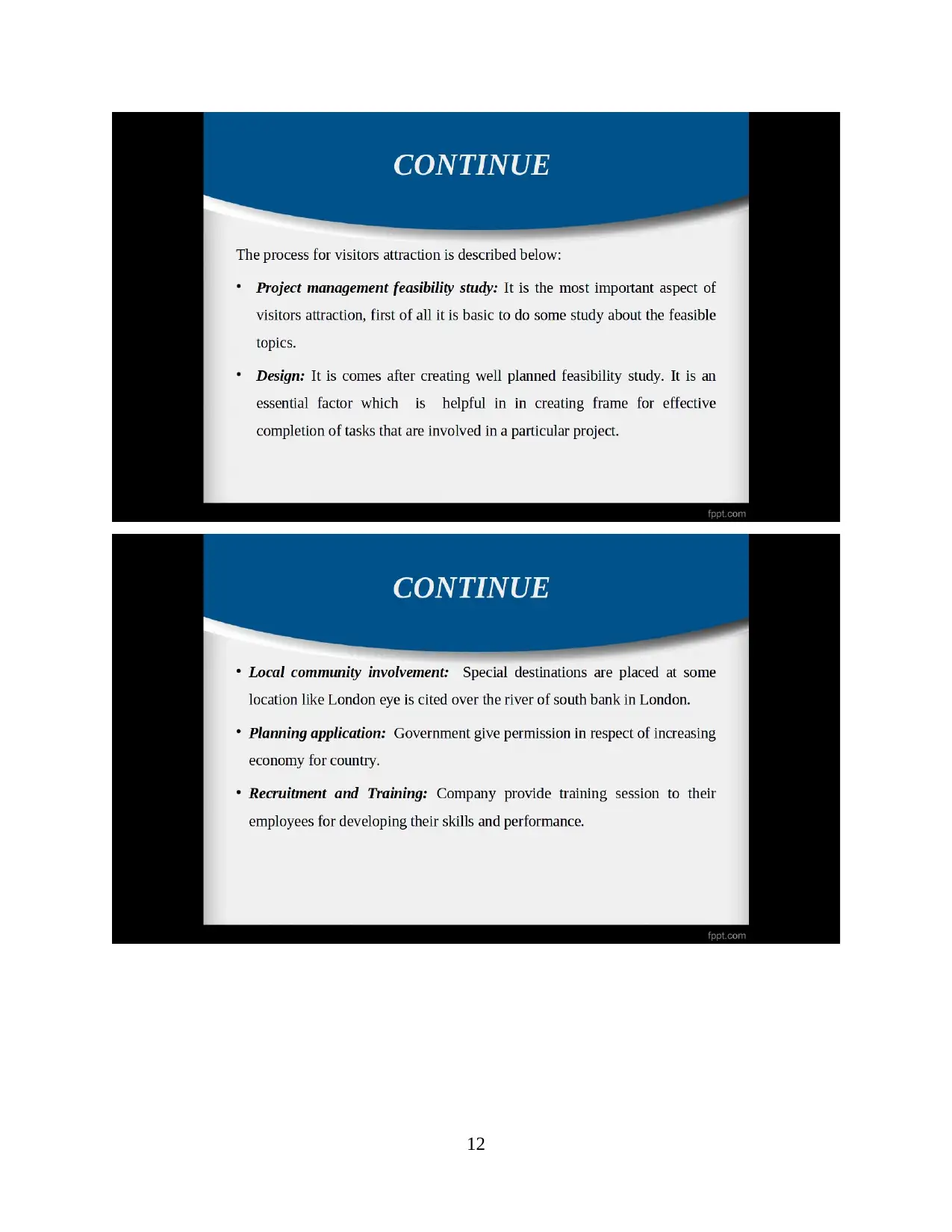
12
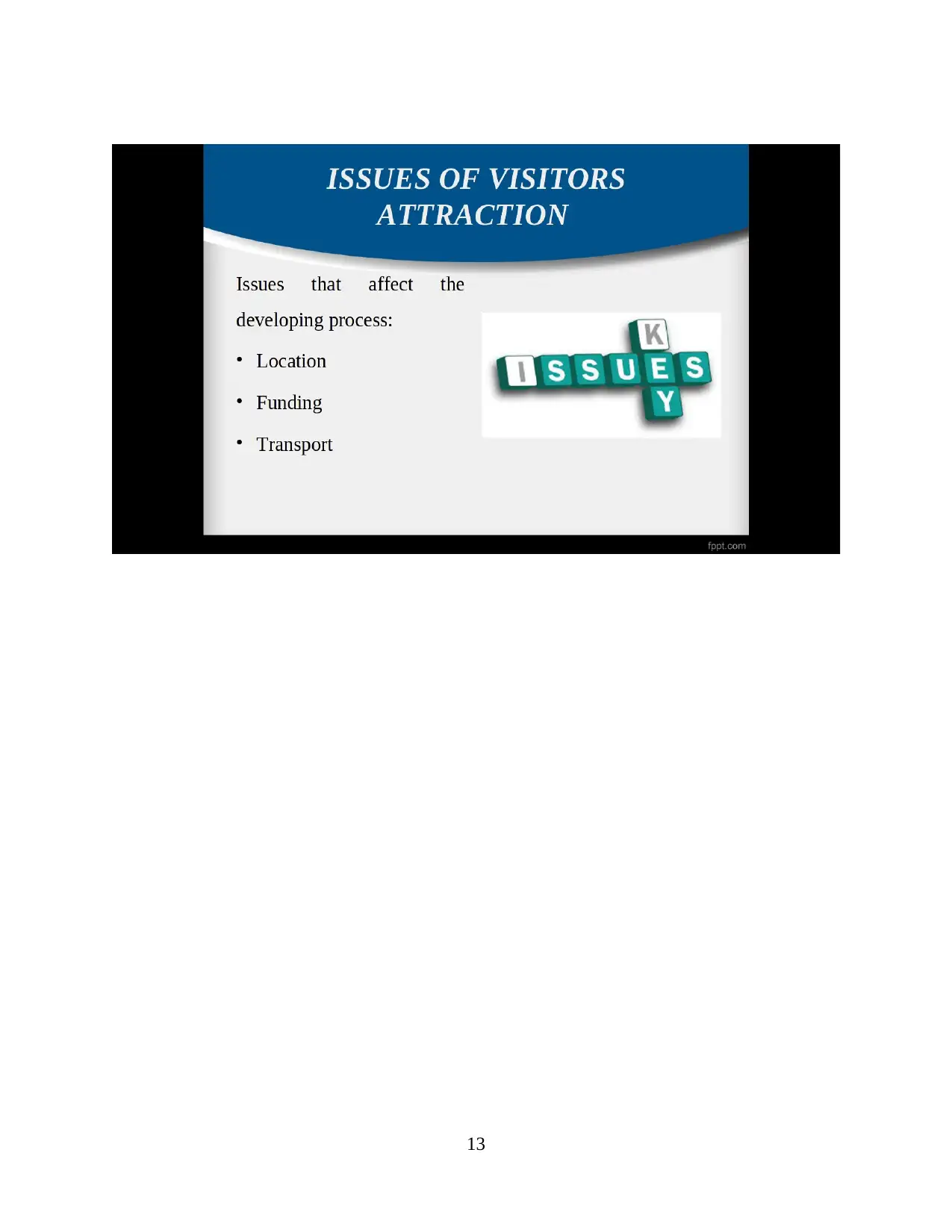
13

14
Secure Best Marks with AI Grader
Need help grading? Try our AI Grader for instant feedback on your assignments.

15

TASK 4
4.1 Various visitor management strategies
Every company use various strategy to attract large number of and tourist towards their
organisation. The national tourism agency is focused towards increasing the number of visitors in
order to developing their productivity and profit. Some visitors management strategies are
described as below:
Comfortable and reasonable accommodation: The basic aim of every firm Is to provide
a well cited accommodation in very reasonable price (Morrison, 2013). National tourism agency
tie up with popular hotels are try to provide best place to stay.
Online facilities: It is most innovative strategy which is followed by tourism agencies.
Through this they provide full detail about the rooms, foods, different packages. In this company
provide online payment facility to make transaction more effective.
Easy transportation: The major aim of every firm is to give comfortable trip to their
customers in order to satisfying the needs and wants. They provide transportation facility to their
clients to visit and taking advantage of various new and unique things. Easy transportation helps
to make trip more easy and comfortable.
16
4.1 Various visitor management strategies
Every company use various strategy to attract large number of and tourist towards their
organisation. The national tourism agency is focused towards increasing the number of visitors in
order to developing their productivity and profit. Some visitors management strategies are
described as below:
Comfortable and reasonable accommodation: The basic aim of every firm Is to provide
a well cited accommodation in very reasonable price (Morrison, 2013). National tourism agency
tie up with popular hotels are try to provide best place to stay.
Online facilities: It is most innovative strategy which is followed by tourism agencies.
Through this they provide full detail about the rooms, foods, different packages. In this company
provide online payment facility to make transaction more effective.
Easy transportation: The major aim of every firm is to give comfortable trip to their
customers in order to satisfying the needs and wants. They provide transportation facility to their
clients to visit and taking advantage of various new and unique things. Easy transportation helps
to make trip more easy and comfortable.
16
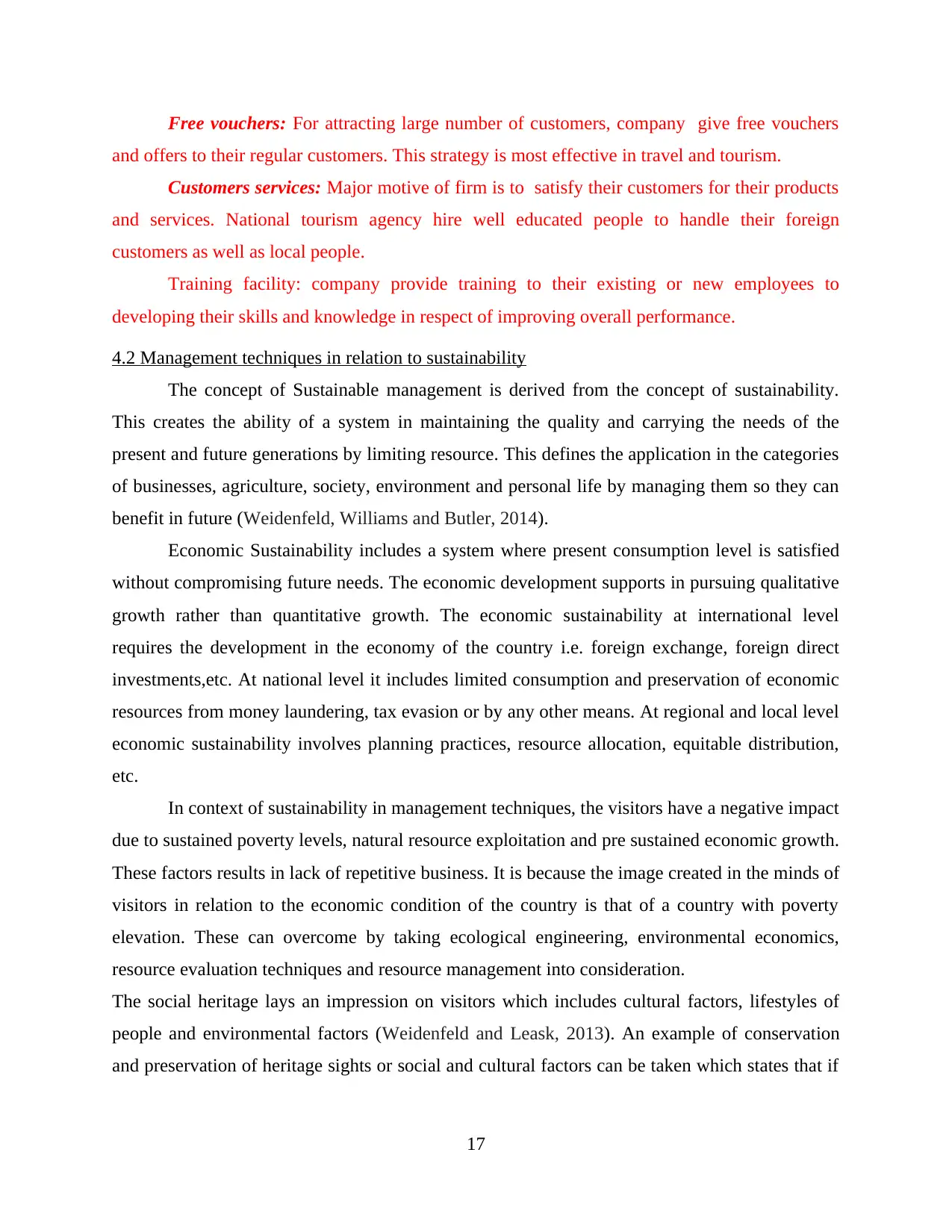
Free vouchers: For attracting large number of customers, company give free vouchers
and offers to their regular customers. This strategy is most effective in travel and tourism.
Customers services: Major motive of firm is to satisfy their customers for their products
and services. National tourism agency hire well educated people to handle their foreign
customers as well as local people.
Training facility: company provide training to their existing or new employees to
developing their skills and knowledge in respect of improving overall performance.
4.2 Management techniques in relation to sustainability
The concept of Sustainable management is derived from the concept of sustainability.
This creates the ability of a system in maintaining the quality and carrying the needs of the
present and future generations by limiting resource. This defines the application in the categories
of businesses, agriculture, society, environment and personal life by managing them so they can
benefit in future (Weidenfeld, Williams and Butler, 2014).
Economic Sustainability includes a system where present consumption level is satisfied
without compromising future needs. The economic development supports in pursuing qualitative
growth rather than quantitative growth. The economic sustainability at international level
requires the development in the economy of the country i.e. foreign exchange, foreign direct
investments,etc. At national level it includes limited consumption and preservation of economic
resources from money laundering, tax evasion or by any other means. At regional and local level
economic sustainability involves planning practices, resource allocation, equitable distribution,
etc.
In context of sustainability in management techniques, the visitors have a negative impact
due to sustained poverty levels, natural resource exploitation and pre sustained economic growth.
These factors results in lack of repetitive business. It is because the image created in the minds of
visitors in relation to the economic condition of the country is that of a country with poverty
elevation. These can overcome by taking ecological engineering, environmental economics,
resource evaluation techniques and resource management into consideration.
The social heritage lays an impression on visitors which includes cultural factors, lifestyles of
people and environmental factors (Weidenfeld and Leask, 2013). An example of conservation
and preservation of heritage sights or social and cultural factors can be taken which states that if
17
and offers to their regular customers. This strategy is most effective in travel and tourism.
Customers services: Major motive of firm is to satisfy their customers for their products
and services. National tourism agency hire well educated people to handle their foreign
customers as well as local people.
Training facility: company provide training to their existing or new employees to
developing their skills and knowledge in respect of improving overall performance.
4.2 Management techniques in relation to sustainability
The concept of Sustainable management is derived from the concept of sustainability.
This creates the ability of a system in maintaining the quality and carrying the needs of the
present and future generations by limiting resource. This defines the application in the categories
of businesses, agriculture, society, environment and personal life by managing them so they can
benefit in future (Weidenfeld, Williams and Butler, 2014).
Economic Sustainability includes a system where present consumption level is satisfied
without compromising future needs. The economic development supports in pursuing qualitative
growth rather than quantitative growth. The economic sustainability at international level
requires the development in the economy of the country i.e. foreign exchange, foreign direct
investments,etc. At national level it includes limited consumption and preservation of economic
resources from money laundering, tax evasion or by any other means. At regional and local level
economic sustainability involves planning practices, resource allocation, equitable distribution,
etc.
In context of sustainability in management techniques, the visitors have a negative impact
due to sustained poverty levels, natural resource exploitation and pre sustained economic growth.
These factors results in lack of repetitive business. It is because the image created in the minds of
visitors in relation to the economic condition of the country is that of a country with poverty
elevation. These can overcome by taking ecological engineering, environmental economics,
resource evaluation techniques and resource management into consideration.
The social heritage lays an impression on visitors which includes cultural factors, lifestyles of
people and environmental factors (Weidenfeld and Leask, 2013). An example of conservation
and preservation of heritage sights or social and cultural factors can be taken which states that if
17
Paraphrase This Document
Need a fresh take? Get an instant paraphrase of this document with our AI Paraphraser
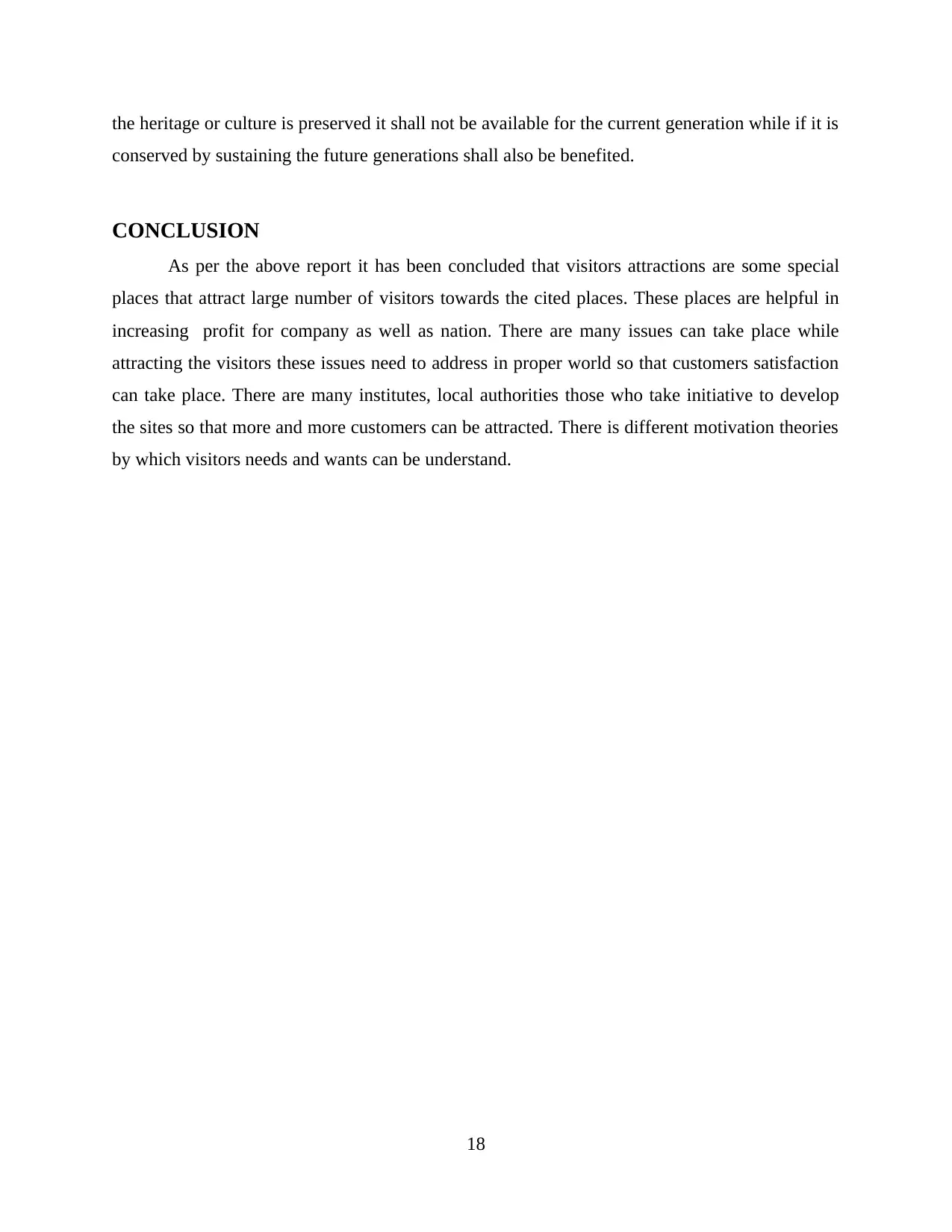
the heritage or culture is preserved it shall not be available for the current generation while if it is
conserved by sustaining the future generations shall also be benefited.
CONCLUSION
As per the above report it has been concluded that visitors attractions are some special
places that attract large number of visitors towards the cited places. These places are helpful in
increasing profit for company as well as nation. There are many issues can take place while
attracting the visitors these issues need to address in proper world so that customers satisfaction
can take place. There are many institutes, local authorities those who take initiative to develop
the sites so that more and more customers can be attracted. There is different motivation theories
by which visitors needs and wants can be understand.
18
conserved by sustaining the future generations shall also be benefited.
CONCLUSION
As per the above report it has been concluded that visitors attractions are some special
places that attract large number of visitors towards the cited places. These places are helpful in
increasing profit for company as well as nation. There are many issues can take place while
attracting the visitors these issues need to address in proper world so that customers satisfaction
can take place. There are many institutes, local authorities those who take initiative to develop
the sites so that more and more customers can be attracted. There is different motivation theories
by which visitors needs and wants can be understand.
18
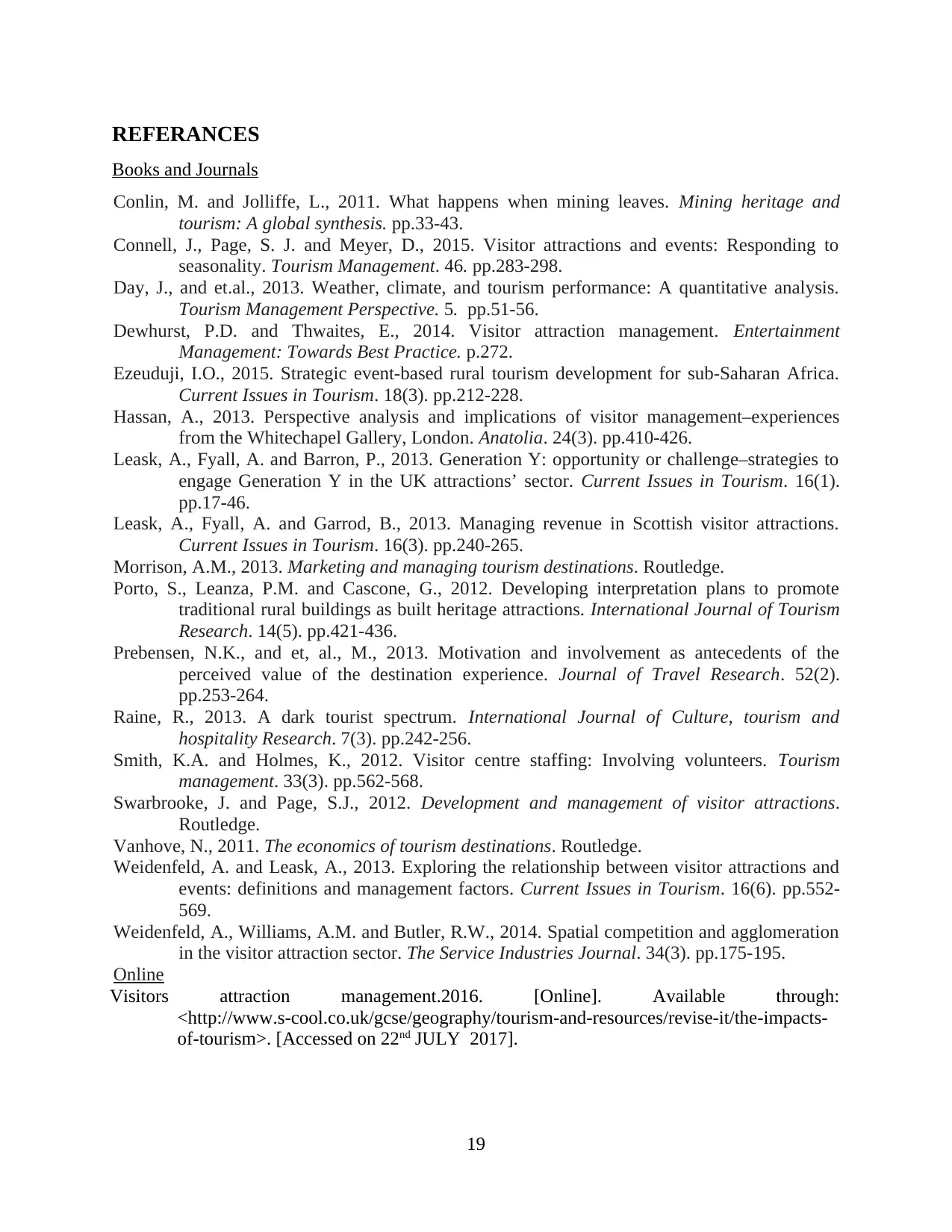
REFERANCES
Books and Journals
Conlin, M. and Jolliffe, L., 2011. What happens when mining leaves. Mining heritage and
tourism: A global synthesis. pp.33-43.
Connell, J., Page, S. J. and Meyer, D., 2015. Visitor attractions and events: Responding to
seasonality. Tourism Management. 46. pp.283-298.
Day, J., and et.al., 2013. Weather, climate, and tourism performance: A quantitative analysis.
Tourism Management Perspective. 5. pp.51-56.
Dewhurst, P.D. and Thwaites, E., 2014. Visitor attraction management. Entertainment
Management: Towards Best Practice. p.272.
Ezeuduji, I.O., 2015. Strategic event-based rural tourism development for sub-Saharan Africa.
Current Issues in Tourism. 18(3). pp.212-228.
Hassan, A., 2013. Perspective analysis and implications of visitor management–experiences
from the Whitechapel Gallery, London. Anatolia. 24(3). pp.410-426.
Leask, A., Fyall, A. and Barron, P., 2013. Generation Y: opportunity or challenge–strategies to
engage Generation Y in the UK attractions’ sector. Current Issues in Tourism. 16(1).
pp.17-46.
Leask, A., Fyall, A. and Garrod, B., 2013. Managing revenue in Scottish visitor attractions.
Current Issues in Tourism. 16(3). pp.240-265.
Morrison, A.M., 2013. Marketing and managing tourism destinations. Routledge.
Porto, S., Leanza, P.M. and Cascone, G., 2012. Developing interpretation plans to promote
traditional rural buildings as built heritage attractions. International Journal of Tourism
Research. 14(5). pp.421-436.
Prebensen, N.K., and et, al., M., 2013. Motivation and involvement as antecedents of the
perceived value of the destination experience. Journal of Travel Research. 52(2).
pp.253-264.
Raine, R., 2013. A dark tourist spectrum. International Journal of Culture, tourism and
hospitality Research. 7(3). pp.242-256.
Smith, K.A. and Holmes, K., 2012. Visitor centre staffing: Involving volunteers. Tourism
management. 33(3). pp.562-568.
Swarbrooke, J. and Page, S.J., 2012. Development and management of visitor attractions.
Routledge.
Vanhove, N., 2011. The economics of tourism destinations. Routledge.
Weidenfeld, A. and Leask, A., 2013. Exploring the relationship between visitor attractions and
events: definitions and management factors. Current Issues in Tourism. 16(6). pp.552-
569.
Weidenfeld, A., Williams, A.M. and Butler, R.W., 2014. Spatial competition and agglomeration
in the visitor attraction sector. The Service Industries Journal. 34(3). pp.175-195.
Online
Visitors attraction management.2016. [Online]. Available through:
<http://www.s-cool.co.uk/gcse/geography/tourism-and-resources/revise-it/the-impacts-
of-tourism>. [Accessed on 22nd JULY 2017].
19
Books and Journals
Conlin, M. and Jolliffe, L., 2011. What happens when mining leaves. Mining heritage and
tourism: A global synthesis. pp.33-43.
Connell, J., Page, S. J. and Meyer, D., 2015. Visitor attractions and events: Responding to
seasonality. Tourism Management. 46. pp.283-298.
Day, J., and et.al., 2013. Weather, climate, and tourism performance: A quantitative analysis.
Tourism Management Perspective. 5. pp.51-56.
Dewhurst, P.D. and Thwaites, E., 2014. Visitor attraction management. Entertainment
Management: Towards Best Practice. p.272.
Ezeuduji, I.O., 2015. Strategic event-based rural tourism development for sub-Saharan Africa.
Current Issues in Tourism. 18(3). pp.212-228.
Hassan, A., 2013. Perspective analysis and implications of visitor management–experiences
from the Whitechapel Gallery, London. Anatolia. 24(3). pp.410-426.
Leask, A., Fyall, A. and Barron, P., 2013. Generation Y: opportunity or challenge–strategies to
engage Generation Y in the UK attractions’ sector. Current Issues in Tourism. 16(1).
pp.17-46.
Leask, A., Fyall, A. and Garrod, B., 2013. Managing revenue in Scottish visitor attractions.
Current Issues in Tourism. 16(3). pp.240-265.
Morrison, A.M., 2013. Marketing and managing tourism destinations. Routledge.
Porto, S., Leanza, P.M. and Cascone, G., 2012. Developing interpretation plans to promote
traditional rural buildings as built heritage attractions. International Journal of Tourism
Research. 14(5). pp.421-436.
Prebensen, N.K., and et, al., M., 2013. Motivation and involvement as antecedents of the
perceived value of the destination experience. Journal of Travel Research. 52(2).
pp.253-264.
Raine, R., 2013. A dark tourist spectrum. International Journal of Culture, tourism and
hospitality Research. 7(3). pp.242-256.
Smith, K.A. and Holmes, K., 2012. Visitor centre staffing: Involving volunteers. Tourism
management. 33(3). pp.562-568.
Swarbrooke, J. and Page, S.J., 2012. Development and management of visitor attractions.
Routledge.
Vanhove, N., 2011. The economics of tourism destinations. Routledge.
Weidenfeld, A. and Leask, A., 2013. Exploring the relationship between visitor attractions and
events: definitions and management factors. Current Issues in Tourism. 16(6). pp.552-
569.
Weidenfeld, A., Williams, A.M. and Butler, R.W., 2014. Spatial competition and agglomeration
in the visitor attraction sector. The Service Industries Journal. 34(3). pp.175-195.
Online
Visitors attraction management.2016. [Online]. Available through:
<http://www.s-cool.co.uk/gcse/geography/tourism-and-resources/revise-it/the-impacts-
of-tourism>. [Accessed on 22nd JULY 2017].
19
1 out of 21
Related Documents
Your All-in-One AI-Powered Toolkit for Academic Success.
+13062052269
info@desklib.com
Available 24*7 on WhatsApp / Email
![[object Object]](/_next/static/media/star-bottom.7253800d.svg)
Unlock your academic potential
© 2024 | Zucol Services PVT LTD | All rights reserved.





